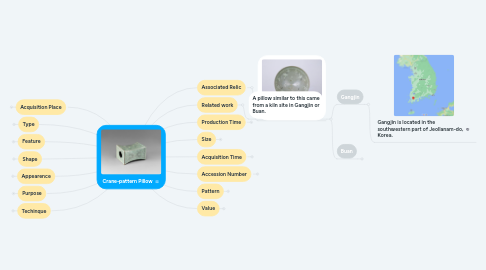
1. Acquisition Place
1.1. This relic was found in Sinan.
1.1.1. Different artifacts were obtained from the same place.
1.1.1.1. Garlic-shaped bottle
1.1.1.2. Black dot-patterned jar
1.1.1.3. Water buffalo-shaped yeonjeok
1.1.1.4. Lion-shaped incense burner
1.1.1.5. Lotus&fish-patterned wan
1.1.1.6. Dragon-pattern prunus vase
1.1.1.7. Kettle
1.1.1.8. Celadon large vase with applique chrysanthemum design
1.1.1.9. Dark-glazed wan
2. Type
2.1. Blue Pottery
2.1.1. Same type of pottery
2.1.1.1. Black dot-patterned jar
2.1.1.2. Water buffalo-shaped yeonjeok
2.1.1.3. Celadon large vase with applique chrysanthemum design
3. Feature
3.1. Goryeo celadon pillow
4. Shape
4.1. 6 wide plates one after another
5. Appearence
5.1. Big hole on the baegetmo and maguri
5.1.1. maguri
5.1.1.1. Different artifacts were obtained from the same place.
5.1.2. baegetmo
5.1.2.1. Baegetmo means the cap on both sides of the pillow. It was placed at both ends of the pillow to take the shape of the pillow or decorate the pillow, and the name of the pillow was determined according to its material or pattern.
5.2. marks of the silica stone
5.2.1. silica stone
5.2.1.1. Silica stone is a mineral mainly composed of silicon and is called throughout silica, which is mainly a raw material for ceramics, glass, and fireproof materials.
5.2.2. found only in 4 places on one side of maguri
5.2.2.1. Proof of indicating that it was baked in a kiln by standing on the side.
5.3. found only in four places on one side of maguri
6. Purpose
6.1. Use it as a pillow
7. Techinque
7.1. reverse inlay technique
7.1.1. Reverse inlay techniques are used for parts other than those intended to be expressed in patterns.
8. Associated Relic
8.1. Crane-pattern Wan
9. Value
9.1. sophisticated decoration and proportions
9.2. highly valuable as a historical material given the small number of Goryeo celadon pillows remaining
9.2.1. Goryeo celadon
9.2.1.1. It is pottery from Goryeo Dynasty with a turquoise color.
10. Pattern
10.1. Cranes and cloud patterns (top and bottom)
10.2. Chrysanthemums (front and back)
10.3. Vine Pattern (front and back)
11. Accession Number
11.1. Sinan 20336
12. Acquisition Time
12.1. This pottery was discovered in 1984.
13. Size
13.1. Height 11.3cm
13.2. Width 16cm
13.3. Length 8.9cm
14. Production Time
14.1. Goryeo Dynasty (13th century)
14.1.1. Goryeo was founded by Wang Geon after unifying the Later Three Kingdoms. It dominated the Korean Peninsula for 474 years and left many cultural properties such as Goryeo celadon and the Tripitaka Koreana. In the late period, it was invaded and interfered with by Mongolia but was destroyed by Lee Seong-gye in 1392.
15. Related work
15.1. A pillow similar to this came from a kiln site in Gangjin or Buan.
15.1.1. Gangjin
15.1.1.1. Gangjin is located in the southwestern part of Jeollanam-do, Korea.
15.1.2. Buan
15.1.2.1. Buan is located on the Byeonsan Peninsula in western Jelloabuk-do, Korea.
